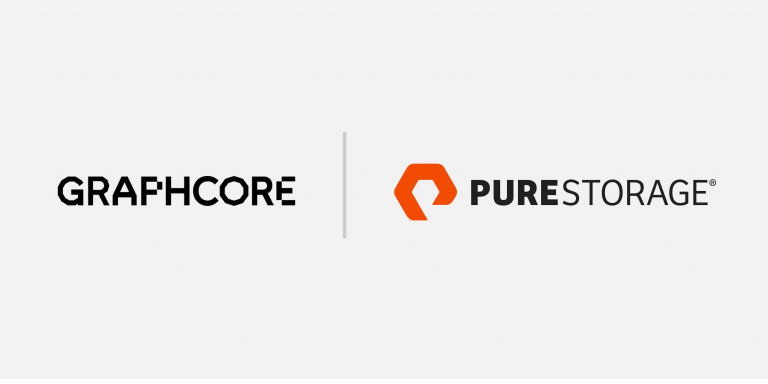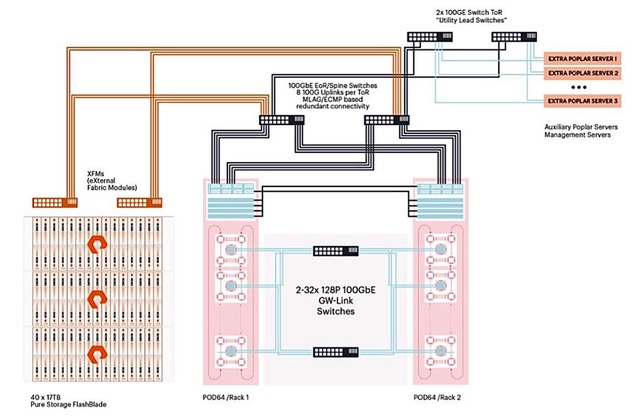
Pure Storage, a leading provider of 100% flash-based block, file and object storage solutions for the enterprise, and Graphcore, a semiconductor company that develops gas pedals for AI and machine learning, have partnered to optimize and deliver the best possible performance for AI computing and are releasing their first reference architecture.
Graphcore
Graphcore, founded in 2016, is a British semiconductor company that develops gas pedals for AI and machine learning. The company has developed an “Intelligence Processing Unit,” or IPU, a microprocessor found on Graphcore’s IPU-POD datacenter computing systems. This new type of processor has been specifically designed to meet the unique and specific needs required for AI and machine learning. It features granular parallelism, single precision arithmetic and sparsity support, among other features. Graphcore’s IPU systems accelerate artificial intelligence and provide a competitive advantage in financial services, healthcare, consumer Internet, academic research and many other fields… The IPU-POD 64, used for this benchmark architecture, maximizes available data center space and power, regardless of how it is provisioned. It can provide up to 16 petaFLOPS of AI computing for training and inference to develop and deploy on the same powerful system.
Pure Storage
Founded in 2009 in California, Pure Storage specializes in flash storage. The company markets 100% flash technologies that are easy to use, efficient and scalable. The solutions it develops are based on a data-centric architecture, allowing companies to simplify production, facilitate the work of developers on a daily basis in order to obtain more accurate analyses. The company has developed FlashBlade, a file and object storage solution.
Graphcore users will benefit from Pure Storage’s flexible and powerful FlashBlade technology as part of their IPU-POD configuration.
FlashBlade, a breakthrough innovation
FlashBlade is an all-flash system, optimized for unstructured data storage and processing, and scalable to multi-petabyte capacity. The system is based on five key innovations:
- High performance storage – all-flash system combining NAND flash with integrated NVRAM.
- Unified network – consolidates high communication traffic onto a single network, supporting IPv4 and IPv6 client access over Ethernet up to 1.6Tb/s.
- Purity/FB storage operating system – symmetric operating system running on FlashBlade array modules, balancing client operation demands across blades.
- Common support architectural design for files and objects: A single underlying support architecture supports concurrent access to files via NFS, NFS over HTTP, SMB, as well as object storage via the Amazon S3 protocol.
- Ease of use: Purity//FB on FlashBlade performs routine administrative tasks autonomously, self-regulates, and provides component failure alerts.
Seamless integration
The Pure Storage and Graphcore reference architecture describes the hosts, storage, and network configuration used in the IPU-POD64 reference architecture that includes the Pure Storage FlashBlade storage solution.
In addition to the IPU-POD configuration, the FlashBlade storage solution was architected as follows:
- 40 x 17TB FlashBlade with redundant external modules (XFM)
- External Fabric Modules connected to Arista Leaf switches via eight 100GbEs configured as a single LACP/MLAG group.

High Performance Results
As part of the joint benchmark architecture, Graphcore and Pure Storage evaluated system performance by running ResNet50 and BERT-Large, as well as a number of standardized storage benchmarks for AI workloads. Near-linear scaling was achieved as the number of jobs running on the infrastructure increased, while optimal IPU performance was delivered with significant bandwidth capacity remaining on the 40-blade system.
For more details on the benchmark performance, see the reference architecture document.
Translated from Graphcore et Pure Storage publient leur première architecture de référence









